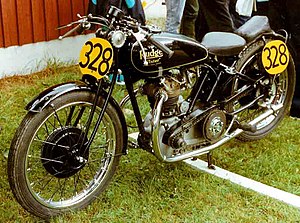
Rudge Whitworth Motorcycles Ulster 1929–1939

 |
|
| Manufacturer | Rudge-Whitworth |
|---|---|
| Production | 1929–1939 |
| Engine | 499 cc (30.5 cu in) OHV single |
The Rudge Ulster was a British motorcycle manufactured by Rudge-Whitworth from 1929 until the outbreak of World War II.
Development

Rudge-Whitworth's last production racing motorcycle was named after Graham Walker's 1928 race win in the Ulster Grand Prix, only the second time a road race had been won at over 80 mph (130 km/h). Graham was the father of racing commentator Murray Walker and was made Rudge Sales Manager in 1929. His win was particularly welcome as he had been unlucky in the Isle of Man TT on the same motorcycle two months earlier, when he narrowly lost the Senior TT race due to oil flow problems on the last lap.
Originally developed as a racing prototype, the production model was essentially a race replica. Various modifications and improvements were made over the ten years of production. Early models had a 'pent roof' four valve head, with two pairs of valves operating on parallel slopes like a 'pitched roof', which was replaced in 1932 with a radial four valve head and an option of a foot operated gear change. This foot pedal operated both the front and rear brakes, with a hand lever also operating the front brake. With a top speed of over 90 mph (140 km/h), the Rudge Ulster was advertised as "probably the fastest 500cc motorcycle in production".
1933 was the era of the Great Depression and Rudge, struggling to make the sales needed to further develop the Ulster, went into receivership. In 1936 EMI (previously the Gramophone Company Ltd. and maker of HMV records), who were a major creditor, took over and resurrected the Rudge Ulster and moved production to their works in Hayes, Middlesex in 1937. The valve gear, which had always been exposed to the elements was sorted out in 1937, when a cast alloy cover was added - although the bronze cylinder head remained until it was replaced with a light alloy example in 1939. Production ended with the outbreak of the Second World War, when EMI had to put all their resources into the manufacture of Radar and electronic equipment for the war effort. From the days of the Gramophone Company, EMI, had had a policy of diversifying productions into other fields, like typewriters, as a strategy to avoid downturns and recessions.
Racing success
As well as Walker's 1928 Ulster Grand Prix win, in the same year Ernie Nott secured the world two-hour record at over 100 mph (160 km/h) on the Rudge and set further records in 1929. In 1930, under the guidance of team boss George Hack, Nott, Walker, Smith and Wal Handley were on Rudge 500 cc motorcycles for the Isle of Man TT Senior race, Handley winning at a record speed of 74.24 mph (119.48 km/h) with Graham Walker coming second, Smith 6th and Nott 7th, winning the Team Prize for Rudge.
Pictured
In 1928 Graham Walker won the Ulster GP averaging a record 130kph.
He was riding a Rudge Whitworth 4 valve head engine which was new and obviously powerful. The set up went on to win the 1930 TT (Senior and Junior) with the same design. The engine boasted a unique pent roof combustion chamber and a radically different exhaust valve set up which gave much better top end gas flow to the twin exhaust pipe set up. This plus an alloy bronze cylinder head and a pressed roller crankshaft combined with the in-house designed gear box gave this model quite the technical advantage over the opposition.
The 500cc OHV Twin Port racing Rudge (On Methanol) was bought from David Warren (ex-president of the NZCMRR) out of Auckland, capable of easily over 100mph and clocked at 105mph at Hampton Downs in 2014.
This particular bike won many New Zealand and Australian Classic racing titles including the New Zealand Classic Racing Register Vintage Championship (NZCMRR) 2008 and the NZCMRR pre-war class in 2009. In 2010 it was raced as a hand change (Vintage Class) in the pre-war Classification and took second place. It won the Gianne Perrone trophy for the NZCMRR Vintage scratch race in 2008, 2009 and 2010. It also won the Burt Munro Pre 1963 girder Fork Class Trophy for the Teratonga Park races in 2009.
Since joining the Nelson collection and ridden by David Warren and Wayne Daniel, this bike has been seen at the Lady Wigram Memorial trophy races at Ruapuna and the Nelson Port races in 2013, as well as competing in the NZCMRR meetings at Pukekohe 2011/2012, Hampton Downs 2013 and 2014 winning the Veteran class title in 2013.
It is an absolute joy to race with very good manners, great brakes and an unbelievable ‘get off the line’ attitude. It usually finishes well ahead of much later designed and raced pre war machinery.
The motor and gearbox were overhauled in 2013 with a new big end and side main bearings fitted (the piston and rings were not touched). Nelson’s TT Industries provided new internals for the 4 speed gear box which were a vast improvement over the well-worn originals.
This little green bike is a gem amongst the other more valuable bikes in the collection and on the track it punches well above its weight and class.
